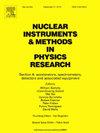15岁:大型强子对撞机运行中的ALICE TOF探测器
IF 1.5
3区 物理与天体物理
Q3 INSTRUMENTS & INSTRUMENTATION
Nuclear Instruments & Methods in Physics Research Section A-accelerators Spectrometers Detectors and Associated Equipment
Pub Date : 2025-04-21
DOI:10.1016/j.nima.2025.170521
引用次数: 0
摘要
ALICE飞行时间(TOF)探测器由1593个多间隙电阻板室(mrpc)组成,以氟里昂(93%)和SF6(7%)的混合物工作,覆盖总有效面积约140平方米,拥有超过150,000个读出通道。在最近一次LHC关闭期间,探测器的读数进行了重大升级,允许连续的数据采集,因此,充分利用LHC在Pb-Pb碰撞中提供的增加的亮度。由于时间分辨率为68 ps, ALICE TOF探测器为识别在大型强子对撞机高能pp、pA和AA碰撞中产生的中间动量带电粒子提供了一个至关重要的工具。这个特征在高能核物理学中是基本的,因为它允许对已识别的粒子产生进行基本测量,这用于表征重离子碰撞中产生的夸克胶子等离子体。经过15年的运行,探测器的性能依然优异,运行的稳定性和粒子检测的效率都没有下降。本文从操作和稳定性两个方面介绍了探测器的性能。讨论了连续读出方案中探测器的校准程序,以及对粒子识别的影响。本文还将介绍一些物理分析中的PID实例。本文章由计算机程序翻译,如有差异,请以英文原文为准。
15 years young: The ALICE TOF detector in the LHC Run 3
The ALICE Time Of Flight (TOF) detector consists of 1593 Multigap Resistive Plate Chambers (MRPCs) operating with a mixture of Freon (93%) and SF (7%), covering a total active area of about 140 m and accounting for more than 150,000 readout channels. During the latest LHC shutdown, the detector underwent a major upgrade of its readout, allowing for continuous data taking and, therefore, fully exploiting the increased luminosity provided by the LHC in Pb–Pb collisions. Thanks to a time resolution of 68 ps, the ALICE TOF detector provides a crucial tool for identifying charged particles produced at intermediate momenta in high energy pp, pA, and AA collisions at the LHC. This feature is fundamental in high-energy nuclear physics as it allows for basic measurements of the identified particle production, which is used to characterize the Quark Gluon Plasma created in heavy-ion collisions.
After 15 years of operations, the detector performance remains excellent, with no degradation in the stability of operation or in the efficiency of particle detection. The detector performance is presented in the paper, also in terms of operations and stability. The calibration procedures of the detector in the continuous readout scheme are discussed, along with the implications for particle identification. A few PID examples in physics analysis will also be described.
求助全文
通过发布文献求助,成功后即可免费获取论文全文。
去求助
来源期刊
CiteScore
3.20
自引率
21.40%
发文量
787
审稿时长
1 months
期刊介绍:
Section A of Nuclear Instruments and Methods in Physics Research publishes papers on design, manufacturing and performance of scientific instruments with an emphasis on large scale facilities. This includes the development of particle accelerators, ion sources, beam transport systems and target arrangements as well as the use of secondary phenomena such as synchrotron radiation and free electron lasers. It also includes all types of instrumentation for the detection and spectrometry of radiations from high energy processes and nuclear decays, as well as instrumentation for experiments at nuclear reactors. Specialized electronics for nuclear and other types of spectrometry as well as computerization of measurements and control systems in this area also find their place in the A section.
Theoretical as well as experimental papers are accepted.

 求助内容:
求助内容: 应助结果提醒方式:
应助结果提醒方式:


